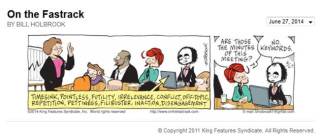 When I ask people to describe the attributes that make a successful leader, I often get the answer, “I can’t tell you in words, but I know it when I see it.” How can something as important as leadership be an indescribable, non-tangible characteristic? Recently I heard an interview with two Jesuit scientists who described how they balanced their faith and scientific quests. They credit the concept of “Educated Ignorance” as the awareness of what we don’t know. This concept frees them to imagine an enormous number of possibilities that their inquiries can follow. While some of us fear the unknown assoicated with black holes, these two men seemed to thrive on what they call the “Joy of Ignorance.”
When I ask people to describe the attributes that make a successful leader, I often get the answer, “I can’t tell you in words, but I know it when I see it.” How can something as important as leadership be an indescribable, non-tangible characteristic? Recently I heard an interview with two Jesuit scientists who described how they balanced their faith and scientific quests. They credit the concept of “Educated Ignorance” as the awareness of what we don’t know. This concept frees them to imagine an enormous number of possibilities that their inquiries can follow. While some of us fear the unknown assoicated with black holes, these two men seemed to thrive on what they call the “Joy of Ignorance.”
My “aha” take away: leadership is not about knowing all the answers. It is about having the courage to continue forward through uncertainty.
Leaders often can’t be certain of an outcome. That’s where they rely on their risk management skills. They leverage their past experience and their current knowledge to guide their teams forward. If the journey’s path was well-defined, there would be maps, alternate directions, and other travel support tools. It would be a middle-management bureaucratic milieu.
So what is the secret sauce for a successful leader? Is there a recipe aspiring professionals can apply? How do managers and leaders help their teams solve the complex challenges that will help them achieve their operational and strategic goals?
Karen Langer, a Harvard-based Social Psychologist, spent a year working with students at the Harvard School of Business. At the end of the year, she recognized the characteristics of mindlessness and mindfulness as a a means for describing successful leadership:
“Mindlessness is the application of yesterday’s business solutions to today’s problems.
Mindfulness is the attunement of today’s demands to avoid tomorrow’s difficulties.”
It is not possible to measure how mindful or mindless a leader might be; these characteristics, the same as other leadership traits, continue to be intangible. The awareness of leaders regarding what they don’t know enable them to reflect on previous experiences and adapt lessons learned in order to be ready resolve uncertainties. Leadership is not necessarily about previous performance; it is about having the courage to seek out new solutions that are best-suited to evolving environments.








